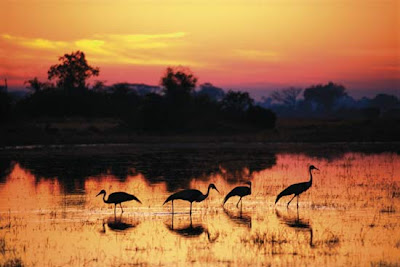Kafue National Park is the largest national park in Zambia, covering an area of about 22,400 square km. It is the second largest park in Africa and is home to over 55 different species of animals.The park is named for the Kafue River. It stretches over three provinces: North Western, Central and Southern. Kafue is Zambia’s oldest park and by far the largest. It was proclaimed in 1950 and is spread over 22 400 square kilometres - the second largest national park in the world and about the size of Wales. Despite the Park’s proximity to both Lusaka and the Copperbelt, it has remained underdeveloped until the most recent years. Despite the depravations of poaching and lack of management, the Park is still a raw and diverse slice of African wilderness with excellent game viewing, birdwatching and fishing opportunities. From the astounding Busanga Plains in the North-western section of the Park to the tree-choked wilderness and the lush dambos of the south., fed by the emerald green Lunga, Lufupa and Kafue Rivers, the park sustains huge herds of a great diversity of wildlife. From the thousands of red lechwe on the Plains, the ubiquitous puku, the stately sable and roan antelopes in the woodland to the diminutive oribi and duiker. The solid-rumped defassa waterbuck, herds of tsessebe, hartebeest, zebra and buffalo make for a full menu of antelope. Kafue National Park was established in 1924 after the British colonial government moved the traditional owners of the area, the Nkoya people of (King) Mwene Kabulwebulwe, from their traditional hunting grounds into the Mumbwa District to the east. Dissatisfaction with the pace of development in Central Province and a lack of benefit from tourism in the park have led to calls from Nkoya leaders to establish a new province in the area which they have proposed to call Kafue Province

park, south-central Zambia. Established in 1950 and located about 200 miles (322 km) west of Lusaka, the park covers an area of 8,650 square miles (22,400 square km) and consists of a vast and gently undulating plateau, situated along the middle reaches of the Kafue River and its two tributaries, the Lufupa and the Lunga. The vegetation is lush and green, varying from mixed forest, thicket, woodland, and grass in the south to broad alluvial grassland and patches of evergreen forests in the north. Perennial swamps in the northwest drain into the Lufupa River via the Busanga floodplains. The park’s wildlife includes hippopotamus, buffalo, zebra, elephant, black rhinoceros, lion, sable, oribi, kudu, impala, roan antelope, eland, lechwe, gnu, sitatunga, duiker, and crocodile. There are numerous bird species, including openbill, saddlebill, wattled crane, crested crane, jucana, cormorant, Ross’s lourie, Boehm’s bee eater, black barbed barbet, fish eagle, marabou stork, and vulture. There are camps at Ngoma, Kalala, Nanzhila, Chunga, Kafwala, Lufupa, Moshi, and Ntemwa; safaris are conducted on foot. Kafue National Park is the largest national park in Zambia, covering an area of about 22,400 km² (similar in size to Wales or Massachusetts). It is the second largest park in Africa and is home to over 55 different species of animals. The park is named for the Kafue River. It stretches over three provinces: North Western, Central and Southern. The main access is via the Great West Road from Lusaka to Mongu which crosses the park north of its centre. Seasonal dirt roads also link from Kalomo and Namwala in the south and south-east, and Kasempa in the north.

Most of the park lies in the Central Zambezian Miombo woodlands ecoregion characterised by savanna grasslands with Miombo tree species, growing thickly in some patches, with a few small dambos (grasslands which become marshy in the rainy season) interspresed among them. In the south there are stony hills and rocky outcrops where the more sparse Zambezian and Mopane woodlands ecoregion takes over, and Mopane trees adapted to hotter drier conditions replace Miombo. A thin belt of evergreen forest lines the banks of the Kafue River, which has been controversially dammed just outside the park at Itezhi-Tezhi Dam, forming a reservoir within the park. Patches of Baikiaea (teak) and Cryptosepalum evergreen forest occur in the south and west. The jewel in Kafue's crown however is the Zambezian flooded grasslands ecoregion in the north, including the Busanga Swamp and plains. These support large herds of herbivores and their predators. In the dry season the animals keep close to the swamps and marshy creeks and are easily seen. The area is also noted for its birdlife. Ngoma in the south is the headquarters of the park but this area together with th NanzhilaPlains are less visited and have become somewhat run down since the Itezhi-Tezhi Dam was built and more lodges were developed in the north. The reservoir cut the north-south track through the park and now it is necessary to detour outside the park to drive between Ngoma and Chunga.











